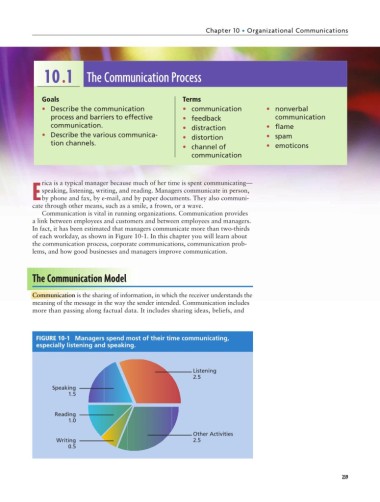Page 252 - Business Principles and Management
P. 252
Chapter 10 • Organizational Communications
10.1 The Communication Process
Goals Terms
• Describe the communication • communication • nonverbal
process and barriers to effective • feedback communication
communication. • distraction • flame
• Describe the various communica- • distortion • spam
tion channels.
• channel of • emoticons
communication
rica is a typical manager because much of her time is spent communicating—
speaking, listening, writing, and reading. Managers communicate in person,
Eby phone and fax, by e-mail, and by paper documents. They also communi-
cate through other means, such as a smile, a frown, or a wave.
Communication is vital in running organizations. Communication provides
a link between employees and customers and between employees and managers.
In fact, it has been estimated that managers communicate more than two-thirds
of each workday, as shown in Figure 10-1. In this chapter you will learn about
the communication process, corporate communications, communication prob-
lems, and how good businesses and managers improve communication.
The Communication Model
Communication is the sharing of information, in which the receiver understands the
meaning of the message in the way the sender intended. Communication includes
more than passing along factual data. It includes sharing ideas, beliefs, and
FIGURE 10-1 Managers spend most of their time communicating,
especially listening and speaking.
Listening
2.5
Speaking
1.5
Reading
1.0
Other Activities
Writing 2.5
0.5
239

